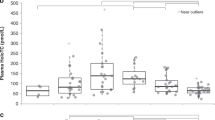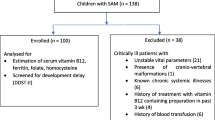Abstract
Background
Plasma methylmalonic acid (MMA) is a specific marker for functional cobalamin deficiency. This deficiency can give rise to non-specific but serious symptoms in childhood such as developmental delay, convulsions and failure to thrive and may even lead to irreversible neurological damage.
Aim of the study
To analyse plasma MMA concentrations in Dutch children and to evaluate possible factors influencing its concentration.
Methods
A number of 186 Dutch children aged 0–19 years were analysed cross-sectionally. Blood was collected to measure MMA, total homocysteine (tHcy), cobalamin (Cbl) and serum creatinine concentrations. In addition, information about medical history, age and sex was recorded.
Results
The geometric mean (GM) plasma MMA concentration was 0.17 µmol/l (95% CI 0.07–0.42) and the GM tHcy was 6.6 µmol/l (95% CI 3.1–13.9). There is a slight positive correlation between plasma MMA and age in children >1 year (r = 0.211, P < 0.05). Plasma MMA concentrations were significantly higher in children with low Cbl concentrations. No significant difference in MMA, Cbl, tHcy or creatinine concentrations between sexes could be observed. Regression analysis showed that Cbl was the strongest determinant of plasma MMA (regression coefficient −0.414, P < 0.05). The association between MMA and Cbl is stronger at increasing age (P for trend 0.045).
Conclusions
Plasma Cbl is the main determinant of MMA in this group of Dutch children. The strength of the association increased with increasing age.

Similar content being viewed by others
References
Allen RH, Stabler SP, Savage DG, Lindenbaum J (1993) Metabolic abnormalities in cobalamin (vitamin-B12) and folate deficiency. FASEB J 7:1344–1353
Beynum van I, Heijer den M, Thomas C, Afman L, Oppenraay-van Emmerzaal D, Blom H (2005) Total homocysteine and its predictors in Dutch children. Am J Clin Nutr 81:1110–1116
Bjorke Monsen AL, Ueland PM, Vollset SE, Guttormsen AB, Markestad T, Solheim E, Refsum H (2001) Determinants of cobalamin status in newborns. Pediatrics 108:624–630
Bjorke Monsen AL, Refsum H, Markestad T, Ueland PM (2003) Cobalamin status and its biochemical markers methylmalonic acid and homocysteine in different age groups from 4 days to 19 years. Clin Chem 49:2067–2075
Bjorke Monsen AL, Ueland PM (2003) Homocysteine and methylmalonic acid in diagnosis and risk assessment from infancy to adolescence. Am J Clin Nutr 78:7–21
Blom HJ, van Rooij A, Hogeveen M (2007) A fast, simple and high throughput method for the determination of methylmalonic acid by LC Tandem MS mass spectrometry. Clin Chem Lab Med 45:645–650
Carmel R (2000) Current concepts in cobalamin deficiency. Annu Rev Med 51:357–375
Casterline JE, Allen LH, Ruel MT (1997) Vitamin B-12 deficiency is very prevalent in lactating Guatemalan women and their infants at three months postpartum. J Nutr 127:1966–1972
Dierkes J, Westphal S (2005) Effect of drugs on homocysteine concentrations (Review). Semin Vasc Med 5:124–139
Van Dusseldorp M, Schneede J, Refsum H (1999) Risk of persistent cobalamin deficiency in adolescents fed a macrobiotic diet in early life. Am J Clin Nutr 69:664–671
Fenton WA, Rosenberg LE (1995) Disorders of propionate and methylmalonate metabolism. In: Scriver CR, Beaudet AL, Sly WS, Valle D (eds). The metabolic and molcular base of inherited diseases, Chapter 41, 7th edn., pp 1423–1449
Fiskerstrand T, Refsum H, Kvalheim G, Ueland PM (1993) Homocysteine and other thiols in plasma and urine: automated determination and sample stability. Clin Chem 39:263–271
Ford C, Rendle M, Tracy M, Richardson V, Ford H (1996) Vitamin B12 levels in human milk during the first nine months of lactation. Internat J Vit Nutr Res 66:329–331
Gellekink H, den Heijer M, Heil SG, Blom HJ (2005) Genetic determinants of plasma total homocysteine (Review). Semin Vasc Med 5:98–109
Graham SM, Arvela OM, Wise GA (1992) Long-term neurologic consequences of nutritional vitamin B12 deficiency in infants. J Pediatr 121:710–714
Grattan-Smith PJ, Wilcken B, Procopis PG, Wise GA (1997) The neurological syndrome of infantile cobalamin deficiency: developmental regression and involuntary movements. Movement Disorders 12:39–46
Jones D, Chesney R (1992) Development of tubular function. Clin Perinatol 19:33–57
Klee GG (2000) Cobalamin and folate evaluation: measurement of methylmalonic acid and homocysteine vs vitamin B12 and folate (Review). Clin Chem 46:1277–1283
Korenke GC, Hunnemann DH, Eber S, Hanefeld F (2004) Severe encephalopathy with epilepsy in an infant caused by subclinical pernicious anaemia: case report and review of the literature. Eur J Pediatr 163:196–201
De Laet C, Wautrecht JC, Brasseur D, Dramaix M, Boeynaems JM, Decuyoer J (1999) Plasma homocysteine concentration in a Belgian school-age population. Am J Clin Nutr 69:968–972
Louwman MW, van Dusseldorp M, van de Vijver FJ (2000) Signs of impaired cognitive function in adolescents with marginal cobalamin status. Am J Clin Nutr 72:762–769
Minet JC, Bisse E, Aebischer CP, Beil A, Wieland H, Lutschg J (2000) Assessment of vitamin B-12, folate, and vitamin B-6 status and relation to sulfur amino acid metabolism in neonates. Am J Clin Nutr 72:751–757
Monagle PT, Tauro GP (1997) Infantile megaloblastosis secondary to maternal vitamin B12 deficiency. Clin Lab Haem 19:23–25
Poele-Pothoff MTWB, van der Berg M, Franken DG, Boers GHJ, Jakobs C, Kroon, Eskes TKAB, Trijbels JMF, Blom HJ (1995) Three different methods for determination of total homocysteine in plasma. Ann Clin Biochem 32:218–220
Rosenblatt DS, Whitehead VM (1999) Cobalamin and folate deficiency: acquired and hereditary disorders in children. Semin Hematol 36:19–34
Schneede J, Dagnelie PC, Staveren van WA, Vollset SE, Refsum H, Ueland PM (1994) Methylmalonic acid and homocysteine in plasma as indicators of functional cobalamin deficiency in infants on macrobiotic diets. Ped Res 36:194–201
Schneede J, Ueland PM (2005) Novel and established markers of cobalamin deficiency: complementary or exclusive diagnostic strategies (Review). Semin Vasc Med 5:140–155
Sniderman L, Lambert M, Giguere R, Auray-Blais C, Lemieux B, Laframboise R et al. (1999) Outcome of individuals with low-moderate methylmalonic aciduria detected through a neonatal screening program. J Pediatr 134:675–680
Specker BL, Brazerol W, Ho ML, Norman EJ (1990) Urinary methylmalonic acid excretion in infants fed formula or human milk. Am J Clin Nutr 51:209–211
Thompson G, Walter J, Bresson J, Ford G, Lyonnet S, Chalmers R et al. (1990) Sources of propionate in inborn errors of metabolism. Metabolism 39:1133–1137
Ueland PM, Refsum H (1989) Plasma homocysteine, a risk factor for vascular disease: plasma levels in health, disease and drug therapy. J Lab Clin Med 114:473–501
Ueland PM, Bjorke Monsen AL (2003) Hyperhomocysteinemia and B-vitamin deficiencies in infants and children. Clin Chem lab Med 41:1418–1426
Verhoef P, Groot de LC (2005) Dietary determinants of plasma homocysteine concentrations (Review). Semin Vasc Med 5:110–123
Wiersinga WJ, Rooij de SEJA, Huijmans JGM, Fischer JC, Hoekstra JBL (2005) De diagnostiek van vitamine-B12-deficiëntie herzien. Ned Tijdschr Geneeskd 149:2789–2794
Acknowledgments
We would like to thank Diny Oppenraay-van Emmerzaal and Per Ueland for their efforts contributing to the determination of laboratory values.
Author information
Authors and Affiliations
Corresponding author
Rights and permissions
About this article
Cite this article
Hogeveen, M., van Beynum, I., van Rooij, A. et al. Methylmalonic acid values in healthy Dutch children. Eur J Nutr 47, 26–31 (2008). https://doi.org/10.1007/s00394-007-0692-5
Received:
Accepted:
Published:
Issue Date:
DOI: https://doi.org/10.1007/s00394-007-0692-5




